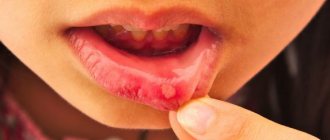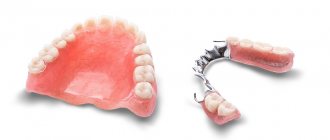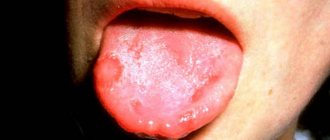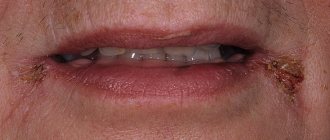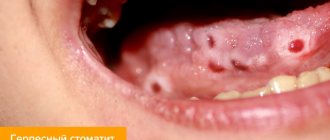Bacterial stomatitis: before and after photos
The causes of infection may be:
- pockets of bacteria accumulation on carious teeth;
- germs entering the mouth due to herpes;
- infection during treatment - bacterial stomatitis can develop if the doctor does not comply with antiseptic rules;
- chronic diseases of various organs;
- contact with a sick person (for example, a kiss).
Symptoms of infectious stomatitis are, first of all, redness of the oral mucosa in the place where microbes entered the wound, swelling, and in the necrotic form, a rash. In children, cracks may form in the mucous membrane, and the gums begin to bleed. The damaged area is itchy and painful.
If bacterial stomatitis is not treated, the temperature rises, a headache appears, the lymph nodes and tonsils become inflamed, and due to intoxication of the body, the rash spreads throughout the body. Children may develop a sore throat and experience pain in the knee joints.
Classification of the disease
Before starting treatment for herpes stomatitis, it is necessary to determine the form and degree of its progression. At the same time, acute herpetic stomatitis in children is diagnosed already when the virus first enters the body.
The severity of the disease is divided into:
- Light. Small blisters form on the oral mucosa - they quickly disappear after they rupture;
- Average. The rashes are more extensive, body temperature rises (up to 38º);
- Heavy. The patient has an abundance of ulcers in his mouth, and after they disappear, new ones appear. Symptoms are supplemented by fever, headache and chills, sometimes the patient feels sick and has diarrhea.
In the absence of proper treatment, chronic recurrent herpetic stomatitis develops. This form of the disease is already characterized by group rashes (on the inside of the cheeks, tongue and palate). The formations combine and form painful erosions. In the recurrent stage, except for rashes, no other symptoms of the disease are noted. The disease may return 2-6 months after treatment.
Treatment of bacterial stomatitis
Self-medication for infectious stomatitis is completely excluded, since it is necessary to accurately identify the pathogen and select drugs that suppress it. Such studies are carried out in the laboratory. This is especially important when it comes to babies. To prevent possible complications, parents of a baby should immediately consult a doctor as soon as they see an inflamed scratch or swelling in the child’s mouth.
When treating bacterial stomatitis, the following are used:
If necrosis has developed, dead tissue is removed surgically, after which it is necessary to completely sanitize the oral cavity.
In parallel with medical measures to eliminate the symptoms of bacterial stomatitis, the patient is prescribed a diet. During this period, it is necessary to ensure maximum sparing of the oral mucosa, limit the consumption of carbohydrates and enrich the diet with vitamins and proteins.
- Superficial (catarrhal). In this case, symptoms of intoxication manifest themselves in a deterioration in appetite and an increase in temperature. There is discomfort when chewing and swallowing food, and the secretion of saliva periodically increases. When examining the oral cavity, a white coating on the tongue is found (on its lateral surfaces there are clearly visible imprints of teeth), bleeding gums, and hyperemia of the mucous membrane. Lack of treatment for catarrhal bacterial stomatitis leads to the disease progressing to the next, more severe form.
- Deep (ulcerative-necrotic). The patient's condition worsens. Symptoms of intoxication intensify: a person has a headache, the temperature rises to high levels, sleep and appetite are disturbed, weakness, irritability, and lethargy appear. Also, bacterial stomatitis in this form is characterized by pain when chewing, bad breath, and increased salivation. When examining the oral cavity, bleeding gums, hyperemia of the mucous membranes, and the presence of ulcers are revealed - first small, covered with a grayish coating, then enlarged, deep, with traces of tissue decay. Immunostimulants. They are necessary to boost immunity and prevent new outbreaks of the disease. These drugs have local and general effects. The doctor selects the optimal treatment option depending on the patient’s condition. For the same purpose, it is recommended to take a course of vitamins.
- Antibiotics. They are prescribed when bacterial stomatitis has become severe or the cause of the disease is systemic diseases of the internal organs. Effective remedies that stop infection directly in the oral cavity are ointments that contain an antibiotic. They give excellent results if the causative agent is a coccal infection. Among the drugs for oral administration in the treatment of bacterial stomatitis, penicillin, lincomycin, gentamicin, kanacimin and others are used.
- Antiseptics. At the initial stage and in the middle of the disease, rinsing with a chlorhexidine solution and treating the mucous membranes of the oral cavity with an anti-inflammatory gel with an analgesic effect are recommended. After the disappearance of acute symptoms, treatment of bacterial stomatitis continues with the help of epithelializing agents that promote rapid healing of defects.
Herpetic stomatitis - symptoms and treatment
Treatment of patients with mild and moderate forms of the disease is carried out on an outpatient basis, i.e. at home, but with regular visits to the doctor. Patients with severe forms of stomatitis, complications and generalized forms of the disease - when the virus affects the entire body - are subject to hospitalization. Treatment includes adherence to the regimen, diet, local and general therapy [5].
All patients require gentle treatment . If the child is lying down, he needs to be provided with fresh air and regular changes of linen. If he plays and refuses to go to bed, there is no need to put him to bed by force - it is better to occupy him with quiet games, reading, etc. You should not go with a sick child to kindergarten, school, shops, shopping centers, cinemas, playgrounds. It must be remembered that the disease is very contagious, and other children can become infected. But during the recovery period, walks in the fresh air separately from other children are possible.
The room where the child is located must be ventilated 3-4 times a day, daily wet cleaning is necessary. The child also needs more sleep. But if he sleeps almost all day and has difficulty waking up or, on the contrary, hardly sleeps, then an additional examination by a doctor is required.
But refusing to eat is not so bad. Eating becomes very painful, so you should not insist, much less force-feed the child. It is worth offering liquid food, porridge, jelly, pureed soups.
It is important to prevent dehydration . Small febrile children become dehydrated very quickly, this increases intoxication and aggravates the condition. Therefore, it is necessary to give the child plenty of water. It is worth offering any liquids: water, compote, tea, diluted juices without sugar. The amount of liquid you drink should be at least 1.5-2 liters. If there is vomiting or the child refuses to drink, you need to give him a teaspoon every 5-7 minutes.
Pain relief also plays an important role . At the height of the disease, patients experience severe headaches and mouth pain. For pain relief, paracetamol and ibuprofen are most often used. The dose is calculated depending on body weight, drugs can be alternated.
Fever above 38.5℃ in young children, in children with a history of febrile seizures or with poor tolerance should be brought down. Fever above 39.5℃ should be reduced in all patients. If, when taking an antipyretic drug, the temperature drops by at least a degree, this is good, but if it does not decrease or rises even higher, then an additional examination by a doctor is required.
With mild severity, it is quite possible to get by with local treatment . This requires careful oral hygiene, rinsing or treatment with antiseptic solutions that do not contain alcohol: furatsilin 1:5000, 2% aqueous solution of chlorhexidine, etc. Acyclovir ointment is used to treat aphthae - 3% for mucous membranes, 5% for skin . From about the third day of illness, healing agents based on an oil solution of vitamin A, sea buckthorn oil, aekol, and solcoseryl are added. Local treatment is carried out 5-6 times a day until the lesions are completely healed.
IMPORTANT : the use of local anesthetics based on lidocaine is not recommended for children under 12 years of age [5]. The use of local aerosol antiseptics for acute herpetic stomatitis is also undesirable.
For moderate forms, local treatment alone is not enough. General antiviral treatment is added . For this purpose, acyclovir and valacyclovir (Valtrex) are used in children. The first drug is used in an age-specific dosage 5 times a day - this is important . Valtrex is used 2 times a day, which is more convenient.
IMPORTANT : interferon preparations (viferon, genferon, cycloferon), as well as homeopathic antiviral agents (anaferon, aflubin) and immunomodulators (imudon, thymogen, lykopid) are not indicated, since their effectiveness and safety in the treatment of infections caused by herpes viruses has not been proven .
Recurrent forms require additional examination by a doctor and the appointment of a prolonged course of antiviral treatment.
Severe and complicated forms of the disease are treated in a specialized hospital, since outpatient treatment will be ineffective [1][2]. It involves taking antiviral drugs in the form of tablets and injections, detoxification therapy, replenishment of lost fluid and electrolytes, and intravenous supply of necessary solutions [11].
It is worth remembering that acute herpetic stomatitis is a disease caused by a virus. Therefore, in routine cases, antibiotics are not required , even if the fever lasts more than three days - this is a typical condition for the disease.
Symptoms of stomatitis
- soreness of the oral cavity;
- bad breath;
- formation of ulcers in the mouth;
- increased body temperature (in severe and widespread form).
At the initial stage of stomatitis, the oral mucosa dries out in the affected areas and becomes shiny. After 1–2 days, a barely noticeable white coating appears. At the next stage of stomatitis, ulcers appear, which are called aphthae. The chronic form of stomatitis is diagnosed when several pathological lesions form in the oral cavity more often than once a year.
Treatment of candidal stomatitis in adults
How to treat the disease “candidal stomatitis”?
First of all, at the first signs of the appearance of red sores, it is necessary to contact a specialist who must correctly diagnose the disease and prescribe treatment. Quick and timely diagnosis is the key to successfully overcoming the disease and eliminating discomfort.
Most often, in the treatment of candidal stomatitis, drugs from the group of antifungal agents are prescribed. Depending on the stage and form of the disease, they are taken 4-7 times a day until any signs of thrush completely disappear. Be sure to consult your doctor before using any medications!
Also during treatment it is necessary to use local antifungal agents, such as:
- A solution of baking soda in water (a teaspoon per glass of water). For better dissolution, the water should be warmed up a little.
- Drops with nystatin.
- Lotions with potassium permanganate. Potassium permanganate dissolves at a rate of 1 to 10,000.
- Asepta rinse solution. It contains an anesthetic component that relieves discomfort. The rinse aid is convenient because it does not require preparation and is immediately ready for use. You can take it with you to work and periodically rinse your mouth with it throughout the day. The solution has an excellent disinfectant effect and relieves burning sensation.
Stages of development of candidal stomatitis
Treatment of candidal stomatitis depends on the degree of its progression. The entire disease can be divided into several stages based on its symptoms, depending on how late it is detected:
- Stage one. The mildest symptoms of oral candidiasis are the appearance of red sores on the mucous membranes: cheeks, lips, as well as on the gums, tongue and tonsils. At this stage, treatment of candidal stomatitis is difficult due to the fact that the disease is still barely noticeable and may not cause serious discomfort, which is why the patient does not see a doctor. The first stage can last quite a long time and not develop into subsequent ones.
- Stage two. A white cheesy coating appears at the sites of the ulcers, which can be removed. When scraped, red and rather painful wounds form at the site of the ulcers. At this stage, the temperature may rise, but only slightly and quite rarely.
- Stage three. The white cheesy coating becomes very difficult to scrape off, the wounds bleed and hurt a lot. This period is dangerous because microorganisms can get into bleeding wounds, which will cause bacterial stomatitis, the course of which is more severe and is accompanied by a very high temperature.
- Stage four. Severe form of candidal stomatitis, requiring immediate action. The upper respiratory tract may be affected, so only a specialist can determine how exactly to treat candidal stomatitis. At this stage, the disease is very dangerous for children.
In addition, it is also important to know that candidal stomatitis is a contagious disease that is transmitted through kissing and even through sharing utensils. We recommend that you undergo full treatment for candidal stomatitis and avoid such contact with other people during your illness.



